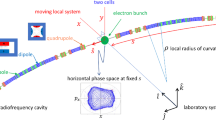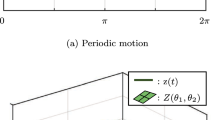Abstract
The article deals with an arbitrary elastic 3D-system (body) that performs a controlled finite rotation with respect to some fixed axis and small nonstationary oscillations. The system oscillations occur due to external load (power control) or inertial load of the rotational transportation of the carrying body (kinematic control). The linear equations of oscillations are used in normal coordinates, in which motion is represented by eigenmodes of vibrations for system that is free in the rotation angle (including system rotation as a solid body in the case of power control) and for system fixed in rotation angle in the case of kinematic control. It is assumed that the (power or inertial)load acting on the system is proportional to some controlling finite time function from a certain class. The purpose of this article is to solve the problem of system rotation for a certain time from one rest position to another at a given finite angle using the given control function and to eliminate the elastic oscillations on the several lowest eigenmodes at the stopping time.
The relations between the time of the system rotation under the action of a given control function and the eigenmodes frequencies for oscillations being eliminated are obtained on the basis of the exact solutions of the equations in normal coordinates. These relations satisfy the zero initial and final conditions. They are “tuned” by minimizing the positive definite quadratic form written for them by varying the system parameters to fulfill these relations simultaneously for several eigenfrequencies. As an example, the calculations for a model of a symmetrical spacecraft with two identical elastic solar cell panels consisting of four planar non-deformable sections connected by elastic hinges are carried out for comparison and analysis of the results accuracy. The finite rolling motion of the system with the damping at the stopping time of rotation for several (from one to three) lowest eigenmodes of antisymmetric vibrations is considered. The comparisons of the initial equations of motion for the system in generalized coordinates using several simple control functions and the found parameters of the “tuned” system with numerical solutions are accomplished.
Similar content being viewed by others
References
F. L. Chernous’ko, N. N. Bolotnik, and V. G. Gradetsky, Manipulation Robots: Dynamics, Control, Optimization (Nauka, Moscow, 1989) [in Russian].
A. S. Kovaleva, Control of Vibrational and Vibro-Impact Systems (Nauka, Moscow, 1990) [in Russian].
K. S. Kolesnikov, V. V. Kokushkin, S.V. Borzykh, and N. V. Pankova, Calculation and Design of Rocket Separation Systems (Izd.-vo MGTU, Moscow, 2006) [in Russian].
G. S. Nurre, R. S. Ryan, H. N. Scofield, and J. I. Sims, “Dynamics and Control of Large Space Structures,” J. Guid., Cont. Dyn. 7(5), 514–526 (1984).
G. L. Degtyarev and T. K. Sirazetdinov, Theoretical Foundations of Optimal Control of Elastic Spacecraft (Mashinostroenie, Moscow, 1986) [in Russian].
S. K. Das, S. Utku, and B. K. Wada, “Inverse Dynamics of Adaptive Space Cranes with Tip Point Adjustment,” AIAA-90-1166-CP, 2367–2374 (1990).
P. M. Bainum and F. Li, “Optimal Large Angle Maneuvers of a Flexible Spacecraft,” Acta Astr. 25(3), 141–148 (1991).
J. K. Chan and V. J. Modi, “A Closed-Form Dynamical Analysis of an Orbiting Flexible Manipulator,” Acta Astr. 25(2), 67–76 (1991).
L. Meirovitch and M. K. Kwak, “Control of Flexible Spacecraft with Time-Varying Configuration,” J. Cont. Guid. Dynam. 15(2), 314–324 (1992).
D.W. Miller and E. F. Crawley, “Theoretical and Experimental Investigation of Space-Realizable Inertial Actuation for Passive and Active Structural Control,” J. Cont. Guid. Dynam. 11(5), 449–458 (1988).
A.E. Zakrzhevskii, “Optimalslewing of a Flexible Spacecraft,” Prikl. Mekh. 39(8), 106–113 (2003) [Int. Appl. Mech. (Engl. Transl.) 39 (10), 1208–1214 (2003)].
J. N. Rotenberg, Automatic Control (Nauka, Moscow, 1971) [in Russian].
A. A. Voronov, Introduction to the Dynamics of Complex Controllable Systems (Nauka, Moscow, 1985) [in Russian].
A. P. Razygraev, Fundamentals of Spacecraft Flight Control (Mashinostroenie, Moscow, 1990) [in Russian].
R. F. Ganiev and A. E. Zakrezhevskii, Programmed Movements of Controlled Deformable Structures (Nauka, Moscow, 1995) [in Russian].
B. P. Masters and E. F. Crawley, “Evolutionary Design of Controlled Structures,” J. Air. 36(1), 209–217 (1999).
V. I. Matyukhin, Controllability of Mechanical Systems (Fizmatlit, Moscow, 2009) [in Russian].
F. L. Chernousko, L. D. Akulenko, and B.N. Sokolov, Control of Oscillations (Nauka, Moscow, 1976) [in Russian].
F. L. Chernousko, I. M. Anan’evskiy, and S. A. Reshmin, Methods for Nonlinear Mechanical Systems Control (Fizmatlit, Moscow, 2006) [in Russian].
V. B. Berbyuk, Dynamics and Optimization of Robotic Systems (Nauova Dumka, Kiev, 1989) [in Russian].
Ye. P. Kubyshkin, “Optimum Control of Rotation of a Rigid Body with a Flexible Rod,” Prikl. Mat. Mekh., 56(2), 240–249 (1992) [J. Appl. Math. Mech. (Engl. Transl.) 56 (2), 205–214 (1992)].
Ye. P. Kubyshkin, “Optimal Control of the Rotation of a System of two Bodies Connected by an Elastic Rod,” Prikl. Mat. Mekh. 78(5), 656–670 (2014) [J. Appl. Math. Mech. (Engl. Transl.) 78 (5), 468–479 (2014)].
T. V. Grishanina, “Controlled Turn of an Elastic Rod at the Finite Angle,” Vest. MAI, 11(1), 64–68 (2004).
T. V. Grishanina, “Elimination of Elastic System Vibrations after its Rapid Movement and Turn,” Vest. MAI, 11(2), 68–75 (2004).
T. V. Grishanina. “Dynamics of Controlled Motion of Elastic Systems Subject to Finite Displacements and Rotations,” Izv. Akad. Nauk. Mekh. Tverd. Tela, No. 6, 171–186 (2004) [Mech. Sol. (Engl. Transl.) 36 (6), 132–144 (2004)].
T. V. Grishanina and F. N. Shklyarchuk, Dynamics of Elastic Controlled Structures (Izd. MAI, Moscow, 2007) [in Russian].
Acknowledgments
The work was carried out within the framework of the state task (state registration number AAAA-A17-117032010144-8) and with partial financial support of the Russian Foundation for Basic Research (project No. 18-08-00778a).
Author information
Authors and Affiliations
Corresponding authors
Additional information
Original Russian Text © T.V. Grishanina, S.V. Ruskikh, F.N. Shklyarchuk, 2018, published in Izvestiya Akademii Nauk, Mekhanika Tverdogo Tela, 2018, No. 4, pp. 16–28.
About this article
Cite this article
Grishanina, T.V., Ruskikh, S.V. & Shklyarchuk, F.N. Elimination of Nonstationary Oscillations of an Elastic System at the Stopping Time after Finite Rotation by the Given Law via the Tuning of Eigenfrequencies. Mech. Solids 53, 370–380 (2018). https://doi.org/10.3103/S0025654418040027
Received:
Published:
Issue Date:
DOI: https://doi.org/10.3103/S0025654418040027




